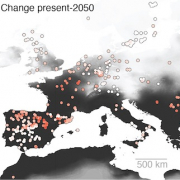Climate change impact on the Arabidopsis genome
Natural selection on the Arabidopsis thaliana genome in present and future climates
Moises Exposito-Alonso, 500 Genomes Field Experiment Team, Hernán A. Burbano, Oliver Bossdorf, Rasmus Nielsen & Detlef Weigel
Nature, published online August 28, 2019
Through the lens of evolution, climate change is an agent of natural selection that forces populations to change and adapt, or face extinction. However, current assessments of the risk of biodiversity associated with climate change do not typically take into account how natural selection influences populations differently depending on their genetic makeup. Here we make use of the extensive genome information that is available for Arabidopsis thaliana and measure how manipulation of the amount of rainfall affected the fitness of 517 natural Arabidopsis lines that were grown in Spain and Germany. This allowed us to directly infer selection along the genome. Natural selection was particularly strong in the hot-dry location in Spain, where 63% of lines were killed and where natural selection substantially changed the frequency of approximately 5% of all genome-wide variants. A significant portion of this climate-driven natural selection of variants was predictable from signatures of local adaptation (R2 = 29–52%), as genetic variants that were found in geographical areas with climates more similar to the experimental sites were positively selected. Field-validated predictions across the species range indicated that Mediterranean and western Siberian populations—at the edges of the environmental limits of this species—currently experience the strongest climate-driven selection. With more frequent droughts and rising temperatures in Europe, we forecast an increase in directional natural selection moving northwards from the southern end of Europe, putting many native A. thaliana populations at evolutionary risk.




